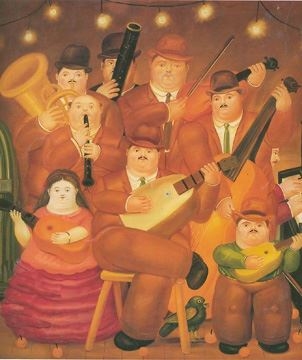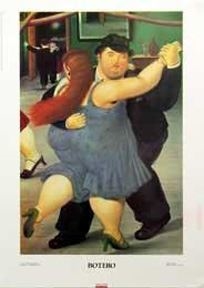 |
| Image from: http://karaart.com/botero/ |
Fernando Botero, the Colombian artist best known for his robust, inflated forms and exaggerated human figures, is both living history, and a living legend.
Botero was born in Medelín, in the department of Antioquia, Colombia, on April 19th, 1932. His father was a travelling salesman who would travel throughout the rugged, mountainous region by donkey. He passed away suddenly of a heart attack when Fernando was only 2, leaving Fernando to grow up with his mother and 2 brothers. It is said that this tragic event left him with a permanent emptiness, a sadness he could never fully put a face to.
The Medellin of modern day is very different than it was when Botero was growing up. Back then, it was a small provincial, quiet town where the church played a large role in everyone’s life and morality. Botero attended a school run by Jesuits who were very strict, and, to add enjoyment to his life, Botero began to draw and later paint. Growing up he became a huge fan of bullfights, which is a popular sport in Colombia, stemming from Spanish settlers. From the age of 13, he began to paint scenes of bullfights, selling them in front of the arena for 5 pesos, and later, as a professional, he spent nearly 2 years painting only that subject.
His talent and knowledge of art was evident from early on. When he was only 17 he contributed an article to the Medellin newspaper, El Colombiano, titled "Picasso and the Nonconformity of Art," which also served to reveal his avant-garde thinking of art.
Botero moved to Bogota in 1951 where he had his first solo exhibition at the Leo Matiz Gallery at the early age of 19. Every single one of his pieces sold. Ironically, Botero grew to have a very difficult time in parting from his work, and became the biggest collector of his own work, despite being offered enormous sums of money for it from fans and collectors around the globe.
 |
| Image from: http://www.art.com/asp/sp-asp/_/ui--ADB30EE9CD754E0781F30BF21C600FC5/PD--10113518/sOrig--CRT/sOrigId--726/Los_Musicos.htm |
Botero, as did many artists of the time, decided to go to Europe to study the work of the Master’s. He studied in Madrid, Spain, at the Academy of San Fernando, where he created work in the style of Velazquea and Goya, as well as in Florence, Italy, where he learned the fresco techniques of the Italian masters. In 1956 he taught at the School of Fine Arts at the University of Bogota, Colombia and traveled to Mexico City to study the work of Rivera and Orozco. There, his experience with Muralism greatly influenced his future direction as an artist.
The painting style Botero is best known for emerged around 1964. It was, and is, characterized by “inflated, rounded forms, painted with smooth, almost invisible brushstrokes, puffing up to an exaggerated size human figures, natural features, and objects of all kinds, celebrating the life within them while mocking their role in the world.” The subjects of his paintings often appear to be posed for a photograph, perhaps to capture their image and persona in complete stillness.
 |
| Image from: http://www.art.com/asp/sp-asp/_/ui--ADB30EE9CD754E0781F30BF21 C600FC5/PD--10113497/sOrig--CRT/sOrigId--726/The_Dancers.htm |
In 1969, he presented his work titled Inflated Images at an exhibition at the Museum of Modern Art in New York. That exhibition established his reputation as a major painter worldwide.
Though the round, exaggerated images are satirical and meant to be humorous, they also serve to offer political and social commentary. Symbols of power and authority are present regularly in his work, with images of presidents and soldiers, as well as clergymen, becoming Botero’s “targets.” He condemns “militarists and the morals and manners of Colombia's bourgeoisie.”
And just like the constant presence of his rotund figures, Botero’s work constantly referred to and portrayed his native Colombia. For example, paintings like 1989’s Man With a Dog, and 1983’s La Colombiana, portray people within settings and backgrounds typical of Colombian scenery. Some of his images even contain the Colombian flag and other such blatant references. Despite his vast, worldly training, images of his childhood seem to have never left his memory. Marc Fumaroli called his paintings “A universe of the unlikely, that comes across so clearly and faithfully in rhetoric, in fables and tales, in short, in childhood.”
Botero’s work is also said to be reminiscent of the famous Colombian author, Gabriel García Márquez, and his extraordinary imagination whose work has created a world “both mundane and wondrous,” just like that of Botero’s.
But as much as his work shows his love for his native region, he also brings in worldwide themes, making his work universal. He brings in themes from all over art history -- from the Middle Ages, to Italian baroque, to Latin American colonial art to modern avant-garde. He also has created parodies of various works of art, including Bonnard and David. During different periods of his work, his art also shows his various influences. For example, his work in the 1960’s clearly shows the influences of the French Paul Gauguin and of Spain’s Pablo Picasso.
But, his work and “persona” is said to best be compared to Peter Paul Rubens, a 17th century artist whom he greatly admires. Rubens’ work was the epitome of “Baroque,” whose fleshy figures “exist in a world of exuberance and plenitude in both the realms of the sacred and the profane.”
Botero once said, “In art, as long as you have ideas and think, you are bound to deform nature. Art is deformation."
Page created on 7/28/2014 10:39:56 AM
Last edited 1/4/2017 9:35:36 PM
